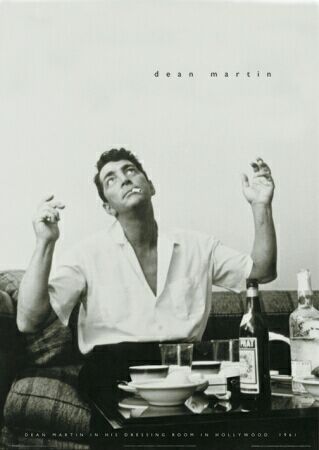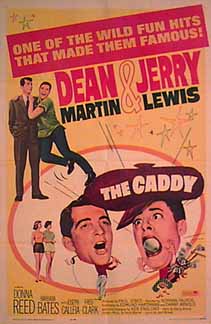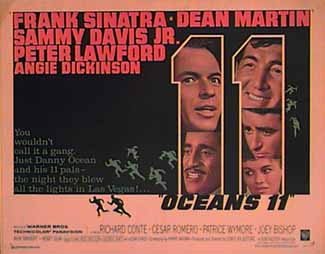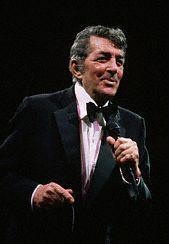

Actor Profile:
DEAN MARTIN
(1917-1995)
 Dean Martin was "always content in a void," his ex-wife Jeannie told biographer Nick Tosches, and, on
Christmas Day 1995, the actor/crooner took up permanent residence in what the dictionary defines as "an empty space," but his lengthy career was anything but empty. Though he started his career as a singer, Martin would reign supreme in both television and movies, proving himself to be much more gifted than he was given credit for.
Dean Martin was "always content in a void," his ex-wife Jeannie told biographer Nick Tosches, and, on
Christmas Day 1995, the actor/crooner took up permanent residence in what the dictionary defines as "an empty space," but his lengthy career was anything but empty. Though he started his career as a singer, Martin would reign supreme in both television and movies, proving himself to be much more gifted than he was given credit for.
Born Dino Paul Crocetti in Steubenville, Ohio, the man we would come to know as Dean Martin worked as a prize-fighter, card-shark, and at a factory before following in the footsteps of his idol, Bing Crosby, by becoming a singer. After a nose job and a change in name, Dino brushed the big time, already a success when he hooked up with a kid named Joseph Levitch who, like the former Mr. Crocetti, believed he had a better shot at fame with a new moniker.
Dean Martin and Jerry Lewis slayed audiences from coast-to-coast with their stage shows, and, in 1948, they made their film debuts, playing second fiddle to Diane Lynn in My Friend Irma. But Martin, the singing straight man, and Lewis, the gooney man-child with a gift for pratfalls, overshadowed the star attraction and were soon launched as the stars in a series of wild comedies, all for Paramount Pictures, most for producer Hal Wallis. At War With the Army, Thatís My Boy, The Stooge, Sailor Beware, Youíre Never Too Young, Living It Up, Pardners, Artists and Models, Scared Stiff, Hollywood or Bust, and other hits cleaned up at the box-office, and, in 1951, the twosome were the number one film stars in the nation. In following years, the duo often found two of their films ranking in the annual roundup of top ten box-office hits. They also headlined their own TV show and, in between, Martin knocked off hit records like "Memories Are Made of This," "Return to Me," and "Thatís Amore."
But Martin was restless, frustrated that his contribution to the teamís success was overshadowed by the more flamboyant Lewis. The comicís artistic ambitions, his desire to direct and write his films just as his idol Charlie Chaplin did also created a wedge between the team. In 1956, following the Christmas release of Hollywood or Bust, it was all over, and the smart money said it was all over for Martin, as well. While Lewis was poised to continue his winning streak as a solo attraction, Martin seemed destined to fade into obscurity.
Lewis did succeed on his own, winning "auteur" status with the likes of Alfred Hitchcock and Orson Welles among French film critics for his eccentric directorial efforts like The Errand Boy and The Nutty Professor, but Martin would succeed, as well, and by the mid-60ís, his popularity would surpass that of his former partner, and, even for a time, that of his Rat Pack crony Frank Sinatra. In 1964, his recording of "Everybody Loves Somebody Sometime" would knock the Beatles out of the number one position on the pop charts.
 Then there were movies. Dino proved he could handle dramatics at least as well as Sinatra by turning in a thoroughly satisfying performance as
John Wayneís alcoholic deputy in Howard Hawksí classic 1959 western Rio Bravo, and by holding his own with Marlon Brando and Montgomery Clift in the war drama The Young Lions. He earned praise for his roles in Some Came Running and Career, but never one to take himself or his profession too seriously, Martin didnít aspire to the acclaim that Lewis and Sinatra craved and devoted most of his onscreen time to such lightweight frolics as Texas Across the River, Bandolero, How to Save a Marriage and Ruin Your Life, Four for Texas, and the Matt Helm spy series (The Silencers, Murdererís Row, The Ambushers, and The Wrecking Crew).
Then there were movies. Dino proved he could handle dramatics at least as well as Sinatra by turning in a thoroughly satisfying performance as
John Wayneís alcoholic deputy in Howard Hawksí classic 1959 western Rio Bravo, and by holding his own with Marlon Brando and Montgomery Clift in the war drama The Young Lions. He earned praise for his roles in Some Came Running and Career, but never one to take himself or his profession too seriously, Martin didnít aspire to the acclaim that Lewis and Sinatra craved and devoted most of his onscreen time to such lightweight frolics as Texas Across the River, Bandolero, How to Save a Marriage and Ruin Your Life, Four for Texas, and the Matt Helm spy series (The Silencers, Murdererís Row, The Ambushers, and The Wrecking Crew).
With Rat Packers Sinatra and Sammy Davis, Jr., he starred in Oceanís 11, Sergeantís 3, and Robin and the 7 Hoods before collecting the biggest paycheck for an actorís services to that time--$7 million--for Airport, 1970ís biggest box-office hit, and, upon its first TV showing over ABC on November 11, 1973, the highest rated movie ever shown in network prime-time. Martin took two more stabs at dramatic roles by appearing alongside Rock Hudson in 1973ís underrated Showdown, and starring as a lawyer in the modest 1975 crime thriller Mr. Ricco but, by then, he had long since given up any aspirations to act, focusing instead on his alternate career as a TV star.
In September 1965, Martin debuted as the star of an NBC variety series, the success of which proved he could be a star in any medium. Leaping onto a piano at the showís start, waving a drink and a cigarette, and slurring or giggling his way through a song, it was here that the Dean Martin who became Americaís favorite entertainer was born. Every Thursday night at 10 p.m. for eight years (and a ninth on Fridays), millions tuned in to watch what was ostensibly a variety show like dozens of others on the air at the time, but Dinoís was unique, less a variety show than a parody of the form. Whereas other hosts were well rehearsed and well behaved, Martin appeared only for the actual taping, making no secret of his reliance on cue cards. His casual, donít give a damn persona mocked those for whom show business was a serious affair. If Dino flubbed a line, it didnít matter. "Itís only a TV show," his attitude suggested. "Letís just have some fun."
 The Dean Martin Show was, in its way, more subversive than Laugh-In, The Smothers Brothers Comedy Hour, Saturday Night Live, or Late Night with David Letterman. It spit in the eye of artistic pretension, just as Martinís movies of the period did. It may have been a reaction to the outrage that greeted Martinís casting in the 1963 William Inge penned drama, Toys in the Attic. The theatrical community made no secret of their belief that the bad boy of Hollywood and Vegas wasnít up to the challenge of such heavy dramatics, and were offended that a mere "entertainer" who admitted to learning his lines while practicing his golf game would even be considered for a piece that had its roots in the "legitimate" theater. The fact that his solid performance was panned seemed to confirm for Martin his hunch that the "arts," including serious acting, were just another side of the coin he had so casually tossed since his days with Lewis. From that point on, Martin appeared to dedicate his career to figuratively mooning his peers in show business.
The Dean Martin Show was, in its way, more subversive than Laugh-In, The Smothers Brothers Comedy Hour, Saturday Night Live, or Late Night with David Letterman. It spit in the eye of artistic pretension, just as Martinís movies of the period did. It may have been a reaction to the outrage that greeted Martinís casting in the 1963 William Inge penned drama, Toys in the Attic. The theatrical community made no secret of their belief that the bad boy of Hollywood and Vegas wasnít up to the challenge of such heavy dramatics, and were offended that a mere "entertainer" who admitted to learning his lines while practicing his golf game would even be considered for a piece that had its roots in the "legitimate" theater. The fact that his solid performance was panned seemed to confirm for Martin his hunch that the "arts," including serious acting, were just another side of the coin he had so casually tossed since his days with Lewis. From that point on, Martin appeared to dedicate his career to figuratively mooning his peers in show business.
By 1973, however, the act grew tired, and revamping his program to feature weekly celebrity roasts only served to demonstrate that the fun was definitely over. Martin would be seen laughing at the antics of his cohorts on the dais, but it was all an illusion. Regardless of who was being roasted, Martin usually wasnít even present, his reaction shots having been duplicated repeatedly and edited into the shows. The same television magic was at work in bringing the guests together at the same time. The shots of a laughing audience revealed the same faces (and the same outfits) week after week, and the home viewer quickly caught on, signaling the death knell for Martinís TV career. Martin had taken his casual style to the outer reaches of laziness, and, instead of being fun, it turned contemptuous.
There were still some appearances remaining--a guest shot on Charlieís Angels, a Tonight Show gig to plug his 1975 Christmas special (in which he sang "Winter Wonderland" while strolling, cigarette in hand, around a swimming pool where bikini clad cuties tossed a beachball), and a supporting role playing himself in Joe Pesciís short-lived Half-Nelson series in 1985. Most notably, there was his 1976 reunion with Jerry Lewis during the latterís annual telethon.
There were also two Cannonball Run movies with Burt Reynolds, and an aborted 1988 concert tour with Sinatra and Sammy Davis, Jr., but for those who never made it to Vegas where he continued to perform occasionally, Martinís career ended almost eight years before his 1995 death. His star shone only in the tabloid press where there were frequent reports of his having to be carried out of restaurants while incoherently "babbling about death." Worse were the rare photographs showing him emaciated, wearing thick glasses, appearing dazed, confused, and just plain worn out. It had seemed like only yesterday that Martin was cranking out westerns and spy spoofs on Hollywood backlots, and laughing his way through maudlin love songs. Times had changed, and olí Dino had changed, too.
 But a Dean Martin revival seems imminent. Elvis Presley cited Martin as his favorite singer, and Rio Bravo is often hailed by Quentin Tarantino as his favorite film. The 1998 death of
Frank Sinatra brought the Rat Pack era back into focus with an HBO movie starring Ray Liotta as Sinatra and Joe Mantegna as Martin that only served to whet appetites for Martin Scorceseís proposed film Dino, based on Nick Tosches fascinating 1992 biography that showed there was much more to Martin than his carefully cultivated public image suggested.
In the long run, wherever Martin ranks in the annals of show-biz, one thing is certain: he provided a much needed blast of irreverence in a profession where the court jesters often confuse themselves with the kings, and Martin was one of the best jesters of all.
But a Dean Martin revival seems imminent. Elvis Presley cited Martin as his favorite singer, and Rio Bravo is often hailed by Quentin Tarantino as his favorite film. The 1998 death of
Frank Sinatra brought the Rat Pack era back into focus with an HBO movie starring Ray Liotta as Sinatra and Joe Mantegna as Martin that only served to whet appetites for Martin Scorceseís proposed film Dino, based on Nick Tosches fascinating 1992 biography that showed there was much more to Martin than his carefully cultivated public image suggested.
In the long run, wherever Martin ranks in the annals of show-biz, one thing is certain: he provided a much needed blast of irreverence in a profession where the court jesters often confuse themselves with the kings, and Martin was one of the best jesters of all.
© Copyright 1999, Brian W. Fairbanks. All Rights Reserved.
Read a Review of
More Actor Profiles
Dean Martin Filmography and TV credits at
More on Dino from Find a Death.com
Visit The Dean Martin Fan Center
That's Amore: A Son Remembers Dean Martin


On Movies and Criticism
FOREWORD from I Saw That Movie, Too